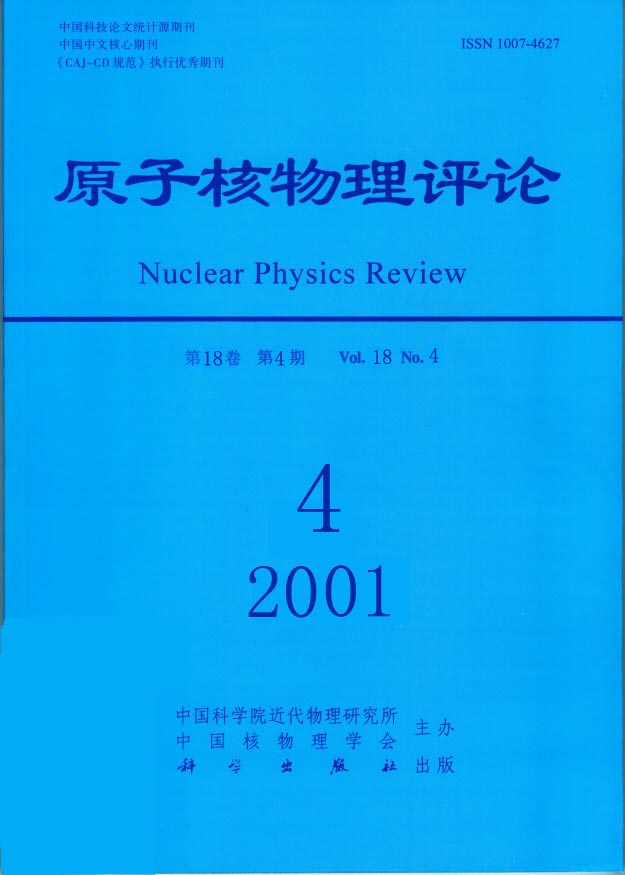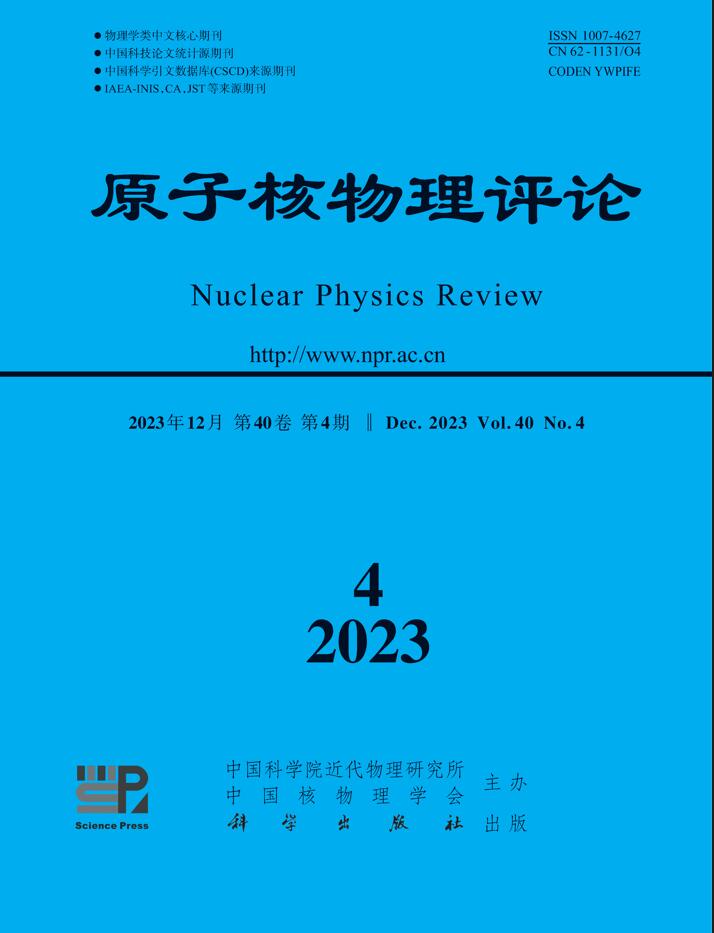2001 Vol. 18, No. 4

Display Method:
2001, 18(4): 201-205.
doi: 10.11804/NuclPhysRev.18.04.201
Abstract:
Based on the dynamical symmetry group characterizing the integrability of classical as well as quantum mechanics, quantum dynamics with proper initial conditions was genuinely formulated, and analytical solutions in the form of soliton-like state evolving around a certain invariant torus were obtained. It has been shown that, in case the intrinsic size of the evolving quantum state is significantly smaller than the extent of its evolving orbit, the motion can be satisfactorily treated with...
Based on the dynamical symmetry group characterizing the integrability of classical as well as quantum mechanics, quantum dynamics with proper initial conditions was genuinely formulated, and analytical solutions in the form of soliton-like state evolving around a certain invariant torus were obtained. It has been shown that, in case the intrinsic size of the evolving quantum state is significantly smaller than the extent of its evolving orbit, the motion can be satisfactorily treated with...
2001, 18(4): 206-214.
doi: 10.11804/NuclPhysRev.18.04.206
Abstract:
Based on the intermediate energy radioactive Ion Beam Line in Lanzhou (RIBLL) of Heavy Ion Research Facility in Lanzhou(HIRFL) and Low Energy Radioactive Ion Beam Line (GIRAFFE) of Beijing National Tandem Accelerator Lab (HI-13) the radioactive ion beam physics and nuclear astrophysics will be researched in detail. The key scientific problems which will be researched as high priority are: the nuclear structure and reaction for nucleus far from β-stability line; the syntheses...
Based on the intermediate energy radioactive Ion Beam Line in Lanzhou (RIBLL) of Heavy Ion Research Facility in Lanzhou(HIRFL) and Low Energy Radioactive Ion Beam Line (GIRAFFE) of Beijing National Tandem Accelerator Lab (HI-13) the radioactive ion beam physics and nuclear astrophysics will be researched in detail. The key scientific problems which will be researched as high priority are: the nuclear structure and reaction for nucleus far from β-stability line; the syntheses...
2001, 18(4): 215-218.
doi: 10.11804/NuclPhysRev.18.04.215
Abstract:
The basic goals for the study of hadronic physics are briefly discussed. The determination of the QCD parameters and the study of the hadron spectroscopy are discussed in more detail. It is shown that BEPC/BES can play a role in the study of hadron physics.
The basic goals for the study of hadronic physics are briefly discussed. The determination of the QCD parameters and the study of the hadron spectroscopy are discussed in more detail. It is shown that BEPC/BES can play a role in the study of hadron physics.
2001, 18(4): 219-224.
doi: 10.11804/NuclPhysRev.18.04.219
Abstract:
Based on the Bethe-Salpeter formalism and the general relativistic covariant quantum field theory, we illustrate with a simple composite model that the observed deviation of (g-2) μ can be an effect of the substructure of muon and give the constraints on the radius of muon in different cases of light constituents and heavy constituents.
Based on the Bethe-Salpeter formalism and the general relativistic covariant quantum field theory, we illustrate with a simple composite model that the observed deviation of (g-2) μ can be an effect of the substructure of muon and give the constraints on the radius of muon in different cases of light constituents and heavy constituents.
2001, 18(4): 225-231.
doi: 10.11804/NuclPhysRev.18.04.225
Abstract:
We studied the topological structure of vortex in the Bose-Einstein condensation with a generalized Gross-Pitaevskii equation in (2+1)-dimensional space-time and 3-dimensional space, respectively. Such equation can be used in discussing Bose-Einstein condensates in heterogeneous and highly nonlinear systems. An explicit expression for the vortex velocity field as a function of the order parameter field is derived in terms of the Φ -mapping theory, and the topological structure of ...
We studied the topological structure of vortex in the Bose-Einstein condensation with a generalized Gross-Pitaevskii equation in (2+1)-dimensional space-time and 3-dimensional space, respectively. Such equation can be used in discussing Bose-Einstein condensates in heterogeneous and highly nonlinear systems. An explicit expression for the vortex velocity field as a function of the order parameter field is derived in terms of the Φ -mapping theory, and the topological structure of ...
2001, 18(4): 232-237.
doi: 10.11804/NuclPhysRev.18.04.232
Abstract:
We show that the degenerate states appearing in the experiment of the condensed vapor of 87 Rb 2 can be described by Yangian. Furthermore, the model for three angular momentum system is solved through Yangian that can be checked by the experiments for lower excited states of Inert Gas atoms under pressure.
We show that the degenerate states appearing in the experiment of the condensed vapor of 87 Rb 2 can be described by Yangian. Furthermore, the model for three angular momentum system is solved through Yangian that can be checked by the experiments for lower excited states of Inert Gas atoms under pressure.
2001, 18(4): 238-244.
doi: 10.11804/NuclPhysRev.18.04.238
Abstract:
Quantum regular and irregular motions are investigated from the viewpoint of dynamical symmetry. The transition from quantum regular motion to chaotic motion is studied by level dynamics and computer experiments. The conditions for onset of quantum chaos are presented.The mechanism for causing chaotic level spectrum is unveiled. The decay behavior of the nuclear ergodic collective states is explained in terms of the peculiar property of chaotic states. The connection between nuclear...
Quantum regular and irregular motions are investigated from the viewpoint of dynamical symmetry. The transition from quantum regular motion to chaotic motion is studied by level dynamics and computer experiments. The conditions for onset of quantum chaos are presented.The mechanism for causing chaotic level spectrum is unveiled. The decay behavior of the nuclear ergodic collective states is explained in terms of the peculiar property of chaotic states. The connection between nuclear...
2001, 18(4): 245-248.
doi: 10.11804/NuclPhysRev.18.04.245
Abstract:
It is found that the radius for a stable strangelet is a decreasing function of temperature in quark mass density- dependent model. To overcome this difficulty, we extend this model to quark mass density- and temperature- dependent model in which the vacuum energy density at zero baryon density limit B depends on temperature. An ansatz B=B 0[1-a(T/T c )+b(T/T c ) 2] is introduced and the regions for the best choice of the parameters are studied.
It is found that the radius for a stable strangelet is a decreasing function of temperature in quark mass density- dependent model. To overcome this difficulty, we extend this model to quark mass density- and temperature- dependent model in which the vacuum energy density at zero baryon density limit B depends on temperature. An ansatz B=B 0[1-a(T/T c )+b(T/T c ) 2] is introduced and the regions for the best choice of the parameters are studied.
2001, 18(4): 249-251.
doi: 10.11804/NuclPhysRev.18.04.249
Abstract:
Electromagnetic masses of neutral K *(892) may be larger than one of charged K *(892). It is unusual and is called K *-EM-mass anomaly. We review the studies on this issue, and point out that K *-mass splitting can be measured in BES accurately.
Electromagnetic masses of neutral K *(892) may be larger than one of charged K *(892). It is unusual and is called K *-EM-mass anomaly. We review the studies on this issue, and point out that K *-mass splitting can be measured in BES accurately.
2001, 18(4): 252-260.
doi: 10.11804/NuclPhysRev.18.04.252
Abstract:
In high energy heavy ion collisions, a possible measure for a certain irregularity of the spectra of produced particles is proposed by using the Wigner-Dyson statistical analysis method. The preliminary results from EMU01 experiments are given by using this statistical analysis method. The analysis shows that the dominant effect is random emission in available high energy nucleus-nucleus collisions at CERN/SPS and BNL/AGS regions.
In high energy heavy ion collisions, a possible measure for a certain irregularity of the spectra of produced particles is proposed by using the Wigner-Dyson statistical analysis method. The preliminary results from EMU01 experiments are given by using this statistical analysis method. The analysis shows that the dominant effect is random emission in available high energy nucleus-nucleus collisions at CERN/SPS and BNL/AGS regions.
2001, 18(4): 261-265.
doi: 10.11804/NuclPhysRev.18.04.261
Abstract:
A method without any approximation to separate the global rotational degrees of freedom in the Schrdinger equation for an N -body system completely from the internal ones is presented. For given orbital angular momentum states, we discover a complete set of independent base-functions, which are homogeneous polynomials in the components of the coordinate vectors and satisfy the Laplace equation. Any function with the given angular momentum and the given parity in the system can be...
A method without any approximation to separate the global rotational degrees of freedom in the Schrdinger equation for an N -body system completely from the internal ones is presented. For given orbital angular momentum states, we discover a complete set of independent base-functions, which are homogeneous polynomials in the components of the coordinate vectors and satisfy the Laplace equation. Any function with the given angular momentum and the given parity in the system can be...
2001, 18(4): 266-273.
doi: 10.11804/NuclPhysRev.18.04.266
Abstract:
The interaction kernel in the Bethe-Salpeter equation for quark-antiquark bound states is derived from the Bethe-Salpeter equations satisfied by the quark-antiquark four-point Green s function. The latter equations are established based on the equations of motion obeyed by the quark and antiquark propagators, the four-point Green s function and some other kinds of Green s functions which follow directly from the QCD generating function. The Bethe-Salpeter kernel derived is an exact...
The interaction kernel in the Bethe-Salpeter equation for quark-antiquark bound states is derived from the Bethe-Salpeter equations satisfied by the quark-antiquark four-point Green s function. The latter equations are established based on the equations of motion obeyed by the quark and antiquark propagators, the four-point Green s function and some other kinds of Green s functions which follow directly from the QCD generating function. The Bethe-Salpeter kernel derived is an exact...
2001, 18(4): 274-275.
doi: 10.11804/NuclPhysRev.18.04.274
Abstract:
In is proved that on the local gauge group C ∞ (M,G) ( M a compact manifold and G a matrix Lie group) there does not exist a finite positive invariant measure.
In is proved that on the local gauge group C ∞ (M,G) ( M a compact manifold and G a matrix Lie group) there does not exist a finite positive invariant measure.
2001, 18(4): 276-281.
doi: 10.11804/NuclPhysRev.18.04.276
Abstract:
The role of momentum dependence equation of state on the nuclear stoppings coming from the isospin dependence of nucleon-nucleon cross section (two-body dissipation ) and the isospin dependence of the mean field (one-body dissipation) are studied by using the isospin dependence quantum molecular dynamics. A detail studies indicate that the difference between the nuclear stoppings coming from the isospin dependence and the isospin independence of in-medium nucleon-nucleon...
The role of momentum dependence equation of state on the nuclear stoppings coming from the isospin dependence of nucleon-nucleon cross section (two-body dissipation ) and the isospin dependence of the mean field (one-body dissipation) are studied by using the isospin dependence quantum molecular dynamics. A detail studies indicate that the difference between the nuclear stoppings coming from the isospin dependence and the isospin independence of in-medium nucleon-nucleon...
2001, 18(4): 282-284.
doi: 10.11804/NuclPhysRev.18.04.282
Abstract:
Current developments in triaxial superdeformed states in nuclei are discussed from a theoretical perspective. A detailed analysis of superdeformed triaxial bands is made with particle-rotor model. Experimental information which may differentiate triaxial superdeformation from axially-symmetric superdeformation is disussed. In order to identify the superdeformed triaxial bands both the energy spectra and electromagnetic transition.
Current developments in triaxial superdeformed states in nuclei are discussed from a theoretical perspective. A detailed analysis of superdeformed triaxial bands is made with particle-rotor model. Experimental information which may differentiate triaxial superdeformation from axially-symmetric superdeformation is disussed. In order to identify the superdeformed triaxial bands both the energy spectra and electromagnetic transition.
2001, 18(4): 285-288.
doi: 10.11804/NuclPhysRev.18.04.285
Abstract:
The development of new experiments for neutron (or proton) halo is briefly described, while the isospin and energy dependence of Glauber theory and its importance in describing halo nuclei-nucleus scattering are discussed.
The development of new experiments for neutron (or proton) halo is briefly described, while the isospin and energy dependence of Glauber theory and its importance in describing halo nuclei-nucleus scattering are discussed.
2001, 18(4): 289-291.
doi: 10.11804/NuclPhysRev.18.04.289
Abstract:
Based on the analysis of neutron-separation energies, Ozawa et al proposed a new magic number N =16 in light neutron-rich nuclei. The deformed and spherical relativistic mean-field(RMF) calculations have been carried out for N =16 isotones. The numerical relativistic mean-field results show there is a shape transition in N =16 isotones. This is the possible cause of the appearance of the new magic number in someneutron-rich nuclei.
Based on the analysis of neutron-separation energies, Ozawa et al proposed a new magic number N =16 in light neutron-rich nuclei. The deformed and spherical relativistic mean-field(RMF) calculations have been carried out for N =16 isotones. The numerical relativistic mean-field results show there is a shape transition in N =16 isotones. This is the possible cause of the appearance of the new magic number in someneutron-rich nuclei.
2001, 18(4): 292-295.
doi: 10.11804/NuclPhysRev.18.04.292
Abstract:
The isoscalar giant monopole resonance for finite nuclei and the nuclear matter incompressibility are studied in a consistent relativistic approach, which achieves a great success in describing the properties of nuclear ground states. The consistency in the relativistic random phase approximation (RRPA) built on the relativistic mean field (RMF) ground states are investigated. The RMF wave function of nucleus and the particle-hole residual interactions in RRPA are calculated from...
The isoscalar giant monopole resonance for finite nuclei and the nuclear matter incompressibility are studied in a consistent relativistic approach, which achieves a great success in describing the properties of nuclear ground states. The consistency in the relativistic random phase approximation (RRPA) built on the relativistic mean field (RMF) ground states are investigated. The RMF wave function of nucleus and the particle-hole residual interactions in RRPA are calculated from...
2001, 18(4): 296-299.
doi: 10.11804/NuclPhysRev.18.04.296
Abstract:
The effects of the dispersion and ground state correlation of the single particle self-energy on neutron matter superfluidity have been investigated in the framework of the Extended Brueckner-Hartree-Fock and the generalized BCS approaches. A sizable reduction of the energy gap is found due to the energy dependence of the self-energy. And the inclusion of the ground state correlations in the self-energy suppresses further the neutron matter superfluidity.
The effects of the dispersion and ground state correlation of the single particle self-energy on neutron matter superfluidity have been investigated in the framework of the Extended Brueckner-Hartree-Fock and the generalized BCS approaches. A sizable reduction of the energy gap is found due to the energy dependence of the self-energy. And the inclusion of the ground state correlations in the self-energy suppresses further the neutron matter superfluidity.
2001, 18(4): 300-307.
doi: 10.11804/NuclPhysRev.18.04.300
Abstract:
We propose that the Pomeron is a Regge trajectory of tensor glueballs with the lightest member having a mass in the 2.2 GeV region and the quantum numbers I G J PC = 0 + 2 ++ . By using the well-established high-energy proton-proton elastic scattering differential cross sections, we show that our conjecture is fully consistent with the observed ξ production data.
We propose that the Pomeron is a Regge trajectory of tensor glueballs with the lightest member having a mass in the 2.2 GeV region and the quantum numbers I G J PC = 0 + 2 ++ . By using the well-established high-energy proton-proton elastic scattering differential cross sections, we show that our conjecture is fully consistent with the observed ξ production data.
2001, 18(4): 308-315.
doi: 10.11804/NuclPhysRev.18.04.308
Abstract:
Some aspects of quantum chaos in a finite system had been studied based on the analysis of statistical behaviors of quantum spectra in heavy and superheavy nuclei. The dependence of the transition from order to chaos on nuclear deformation and nuclear rotatation had been described. The influence of pairing effect on the statistical properties of spectra is also discussed. Some important experiment phenomena in nuclear physics had been understood from the point of view of interplay...
Some aspects of quantum chaos in a finite system had been studied based on the analysis of statistical behaviors of quantum spectra in heavy and superheavy nuclei. The dependence of the transition from order to chaos on nuclear deformation and nuclear rotatation had been described. The influence of pairing effect on the statistical properties of spectra is also discussed. Some important experiment phenomena in nuclear physics had been understood from the point of view of interplay...
2001, 18(4): 316-327.
doi: 10.11804/NuclPhysRev.18.04.316
Abstract:
The essential developments of the nucleon structure studies in the last half century are reviewed. The nucleon spin and magnetic moment structure studies with the polarized lepton nucleon deep inelastic scattering in the recent years are specially analyzed. The important topics in the contamporary studies of the nucleon structure is discussed.
The essential developments of the nucleon structure studies in the last half century are reviewed. The nucleon spin and magnetic moment structure studies with the polarized lepton nucleon deep inelastic scattering in the recent years are specially analyzed. The important topics in the contamporary studies of the nucleon structure is discussed.







 甘公网安备 62010202000723号
甘公网安备 62010202000723号